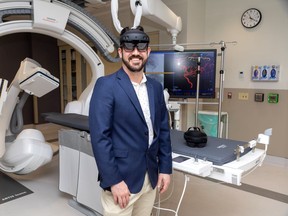High-tech headsets opening London surgeons' eyes: 'Stunning'
London doctors are testing whether a high-tech headset can help surgeons at work, eliminating the need for big-screen clutter during minimally invasive spinal operations and other surgeries.

Article content
London doctors are testing whether a high-tech headset can help surgeons at work, eliminating the need for big-screen clutter during minimally invasive spinal operations and other surgeries.
The research team at London Health Sciences Centre (LHSC) is studying whether the use of HoloLens technology by surgeons – a mixed-reality headset made by Microsoft – can help them monitor important, real-time scans of key internal structures without taking their eyes off the patient.
“The study is assessing the technology’s feasibility, if it’s going to do a good enough job,” said Jonathan Collier, an interventional radiologist behind the project.
During some surgeries, X-ray and CT scans of the patient are taken in real time and displayed on a monitor so surgeons can consult them. The problem is the 152-centimetre screen takes up one whole side of the operating room table so there’s no space for the doctor to stand, Collier said.
The HoloLens technology takes that screen and puts it in the surgeon’s field of vision, so they don’t have to look up at the giant monitor – and away from the patient – while they’re operating. The headset software responds to hand gestures and voice commands from the wearer.
The neuroradiologists who are using the HoloLens in the operating room have the traditional monitor there in case they need it, Collier said. The technology is only being used in lower risk, minimally invasive procedures, such as ones to address spinal pain, but could eventually be used in a wide variety of other operations that involve the use of real-time imaging, said diagnostic and interventional radiologist David Hocking.
“We’re looking to expand this within the hospital to other areas that rely on monitors, as well as into the clinic setting for educational purposes,” said Hocking.
So far, 16 patients have undergone surgeries by headset-wearing surgeons at LHSC. The research project is expecting to include 100 patients by year’s end, Collier said.
The LHSC team is evaluating surgeon feedback on the technology and is making tweaks as they go, Collier said.
“We’re building the software up and it’s getting better and better. We’re taking micro-pauses, making some adjustments, then reaching more patients,” he said.
Though it’s emerging technology, using the headset during surgery has not been a difficult adjustment, said neuroradiologist Sachin Pandey.
“What was stunning was how intuitive it all was,” Pandey said Thursday. “There’s an uncanny feeling of having technology laced over your natural perception, but you get over that really quickly and within a minute or two you feel like a fish to water.”
The team also is exploring if the technology can help patients and their families visualize the issue that is being fixed in surgery in the lead-up to the procedure. The headsets can, for example, display a 3D image of the blood vessel the surgery will fix.
The HoloLens research project was pitched by LHSC doctors and received funding through the hospital’s academic realignment initiative awards. This project and others have received more than $1 million in funding from the London Health Sciences Foundation and Children’s Health Foundation.
LHSC isn’t the only London hospital bringing sci-fi technology into the surgical suite.
In 2022, St. Joseph’s Health Care London celebrated a Canadian first, using the HoloLens technology and 3D holograms of a patient’s bones to plan and guide shoulder surgeries.
The holograms are based on a CT scan of the patient’s bones taken before surgery and give surgeons the chance to analyze a virtual 3D model of the patient’s joint instead of just a 2D x-ray image during the operation.






Postmedia is committed to maintaining a lively but civil forum for discussion. Please keep comments relevant and respectful. Comments may take up to an hour to appear on the site. You will receive an email if there is a reply to your comment, an update to a thread you follow or if a user you follow comments. Visit our Community Guidelines for more information.